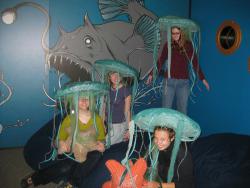Serendip is an independent site partnering with faculty at multiple colleges and universities around the world. Happy exploring!
The Art of Wandering

Phoenix
MLord
Play in the City 028
Sunday, September 15th
The Art of Wandering
The article which most particularly resonates with our trip into Philadelphia is Cass Sunstein’s article, “So Much for Serendipity in Personalized News.” This is not perhaps particularly original, since everyone on the trip most likely found themselves released into a world of serendipity. However, I tried particularly hard to play in the city, to open myself to any and all possibilities for play, and found them delightful.
Upon being freed into the city, my group, consisting of myself, Marcia, Thea, and Agatha, agreed to visit the sculpture garden. There we discovered, among other things, a door decorated with many small figures. Although I rushed past the door at first, Thea pointed out that a large sculpture of three men entitled The Fades was reproduced in miniature on the door, which prompted me to look more closely and find that another large sculpture, apparently a replica of the famous Thinker, was also miniaturized on the door.
Second, we visited the Academy  of Natural Sciences of Philadelphia. Agatha noticed the advertisements on the front for the Glow Exhibit, so we decided to investigate. Glow turned out to be a very dim exhibit illuminated by backlit pictures and words teaching us about bioluminescence, phosphorescence, and fluorescence. At the end of the exhibit, we discovered costumes for fireflies and jellyfish, and, accordingly, dressed up and took pictures. First, we were jellyfish posing in front of an anglerfish. Then, we became fireflies trapping the humans inside a jar. We spent the rest of our time until lunch investigating the live animals of the exhibit, including a cantankerous cockatoo, a friendly milk snake we were allowed to pet, and a multitude of butterflies.
of Natural Sciences of Philadelphia. Agatha noticed the advertisements on the front for the Glow Exhibit, so we decided to investigate. Glow turned out to be a very dim exhibit illuminated by backlit pictures and words teaching us about bioluminescence, phosphorescence, and fluorescence. At the end of the exhibit, we discovered costumes for fireflies and jellyfish, and, accordingly, dressed up and took pictures. First, we were jellyfish posing in front of an anglerfish. Then, we became fireflies trapping the humans inside a jar. We spent the rest of our time until lunch investigating the live animals of the exhibit, including a cantankerous cockatoo, a friendly milk snake we were allowed to pet, and a multitude of butterflies.
At the library, Marcia and I dropped Thea and Agatha off, as they had the first time slot. Marcia and I wandered through the music and fiction sections. I expressed a desire to read The Fault in Our Stars by John Green, and Marcia, a fan of the book, insisted we hunt for it. We were unsuccessful, but we did find Paper Towns by the same author, and I began to read that, instead. So far, it seems an interesting book, but unfortunately, I don’t have a library card. When it was our turn, we were given synchronized iPods and led to sit in certain chairs with stacks of books in front of us. began with a loud whisper, directing us to observe the sights and sounds around us. Eventually, it directed us to read from our books, linking the text we read to the voice. Then the directions began to differ. One person found pages for the other, pointed out paragraphs for the other to read, and then switched roles. The voice directed us to passages in novels, but read the passages with changed words. We left the exhibit intimately aware of every sound we made, of the readers around us, immersed in their books, of the very hands and words the library contained.
In between, I played. I gave myself the freedom to seek out crunchy-looking leaves on the sidewalk and stomp on them, to climb atop a low wall and walk along it instead of the street, to take pictures, and to read. At the end of the trip, I attempted to start a game of Duck Duck Goose. Unfortunately, most of my classmates were too tired to play, but two people joined in, which made it entirely worthwhile. On the walk back to the train station, and on the train itself, Thea and I played I-Spy and Twenty Questions, two games I hadn’t played in many years.
I still relate to the city as a museum-visiting tourist—I even spotted a double-decker tour bus. I still relate to it as a place to view theatre, although this was a unique piece of theatre. One element, though, however small, was different. A city native stopped to ask us if we needed directions. Never has this happened to me before. Never has a resident been able to spare enough of their day to reach out to a humble tourist. It almost gives one hope for the future.
There is, perhaps, a lack of serendipity in my everyday life as a house creature, a hermit who receives her news and her recommendations through customized feeds. The city, on the other hand, offers multiple opportunities for serendipity: in the choice to play an old game, to wander a museum, to stop and play dress-up, to discover a new book, to read an exciting ad and divert to try its product. One only has to go there with purpose but without a packed schedule, which is possibly the answer to finding serendipity everywhere.
Works Cited
Sunstein, Cass. “So Much for Serendipity in Personalized News.” Bloomberg.com. Bloomberg, 12 Aug. 2013. Web. 14 Sept. 2013.


